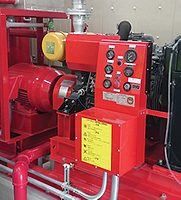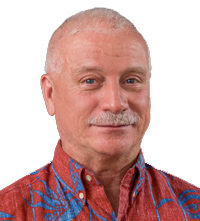Japanese fire pump systems

This month, I will look at some of the features of fire pump installations in Japan. Mind you, this is strictly from the point of view of a Gaijin. Though I’m a frequent visitor to Japan and have worked on many projects there for nearly 40 years, much of the Japanese approach to fire protection, including the codes and standards they use, remains an enigma to me. This is to a large extent because of my limited ability to speak and understand the Japanese language and lack of understanding the written language. It is also in part because the vast majority of my work in Japan has been for the U.S. military on projects with requirements to comply with U.S. codes and standards.
My experience with Japanese fire protection systems derives from building surveys and major renovations of existing buildings at U.S. military installations that were originally funded for design and construction by that the Japanese government. These projects almost exclusively comply with Japanese codes and standards. Japan provides buildings for the use of the U.S. DoD as a form of payment for the U.S.’s role in providing a measure of the defense for Japan. The system set up to develop and deliver these projects is based on agreements between the U.S. State Department and Japan. Officially, the agreement requires that facilities built by the government of Japan (GOJ) must comply with the more stringent of U.S. and Japanese codes. In reality, GOJ facilities are more or less built to Japanese standards.
Why this occurs I don’t know, but I’m more than willing to speculate. Firstly, GOJ projects on U.S. bases technically belong to Japan and are only being lent to us for our use. The projects are funded by Japan, and it is only natural that the person paying has more say in interpreting the agreement. Some think the requirement to comply with the more stringent of U.S. and Japan codes is decided based on the Japanese attitude that, “Japanese codes, in all cases, are better and more stringent that U.S. codes, therefore, the terms of the agreement are met by complying with Japanese codes”.
Or in other words, he who has the gold makes the rules. Also, since Japan is paying for it, it stands to reason that they would want to use Japanese products, materials and methods to the maximum extent possible. Because Japan has no equivalent to the U.S. concept of listing equipment through National Recognized Testing Laboratories, most equipment of Japanese manufacture cannot comply with requirements for equipment that is UL listed or FM approved. This is compounded by the fact that Japan codes and standards are in many cases quite different from those of the West.
There is a strong argument for following one code or standard or other but not both. In the few projects I have seen where a real attempt to use the more stringent requirements of the two countries, it seems you end up with something that looks and functions like it was made on the Island of Dr. Moreau, “Me not man, me not beast, me thing!” (I recommend you see the 1932 movie “Island of Lost Souls” with Bela Lugosi and Charles Laughton, not the 1996 remake).
Now to the Japanese fire pump system. Virtually all sprinkler systems in Japan use a fire pump as part of their water supply in conjunction with a dedicated water tank. I suppose this is an earthquake protection measure. It may also be due to the limited fire protection water supplies that are available from the public water supply system in many areas of Japan.
It is a major difference from what would be required by U.S. standards. The water reservoir is of limited size providing on the order of 20 minute water supply duration. The tanks are arranged for automatic filling, but the fill rate is very low. The tanks are usually below grade and the fire pump room sits on top of the tank. Those of us familiar with NFPA 20 know, in this case, we should opt for a vertical turbine fire pump. Not so in Japan. The Japanese fire pump is horizontal and “lifts” the water out of the tank. In the photograph you see a horizontal fire pump. The vertical galvanized pipe in the right foreground is the steel suction pipe coming from the reservoir. Also, in the photograph, left of the diesel exhaust pipe, is a galvanized cubicle water tank. This is the priming tank used to keep the suction piping filled with water. At the bottom of the suction line is a foot valve. Note: The Japanese do have vertical turbine fire pumps, but they are not commonly used because they are very expensive.
Another NFPA 20 violation, as one can see in the photograph, are the dual drive pumps. We occasionally see these dual drive pumps, but this not the normal case. Most Japan fire pump systems use electric drive pumps only. This points to another potential issue with compliance with NFPA 20, that of reliable power supply. However, I’m not so sure the Japanese got this wrong, just as I’m not sure we in the U.S. have it right. I always wince when I tell a client that since the building has no emergency generator and the electric power supply has been deemed unreliable, we must use a fire pump with a diesel engine drive. In my heart, I believe this code-compliant decision is not the right decision. I would rather take the chance that the lights were on when an electric motor driven fire pump is needed, than be forced to rely on a diesel to start, one that more than likely will not be properly maintained.
In U.S. fire pump installations where the fire pump is required to start automatically on pressure drop, we use a pressure maintenance (jockey) pump. The Japan fire pump uses a pressure tank, pressurized with air, to pressurize the discharge line. This is may not be a violation of NFPA 20, which permits other approved methods for maintaining pressure in automatic start systems. Similarly, the diesel engine uses air cooling rather than a heat exchange loop. Air cooling is permitted by NFPA 20, but in my experience heat exchange loops are pretty much used exclusively for U.S. fire pumps.
The Japanese fire pump controller also does not have all the bells and whistles required by NFPA 20. One obvious thing I have found is that the Japanese fire pump controller cannot meet all the supervision requirements of NFPA 20. The controller has contacts to enable monitoring a fire pump running condition but does not provide a means to monitor that the controller is set for automatic operation. If one puts the pump on manual start no signal that can be monitored is generated by the controller.
When I first saw the typical Japan fire pump installation, being the ugly American that I used to be, I was horrified. How could anyone think of not building a fire pump system meeting NFPA requirements? (I guess the Japanese are not the only ones who think/thought their codes were best). Over the years my outrage has mellowed a bit. I recognize that what the Japanese are doing here is not necessarily wrong; it is just different. (But, they really do sprinkler systems wrong.) I must admit, the few times I’ve had the opportunity to witness the operation of a Japanese fire pump installation they’ve started and were able to maintain suction. I’ve heard of instances where larger capacity horizontal fire pumps had some difficulty lifting the water.
This issue with supervision relates to what I believe is an overall Japanese attitude about themselves. In the U.S., through NFPA codes and standards, we try to make fire stuff as reliable as possible; we try to make it idiot-proof. The Japanese do not assume their people are idiots; they expect more from them, and they seem to get it. The fire pump controller does not need to be monitored for switch in manual-or-off position because in Japan, that condition is not likely to occur. They must be doing something right; just compare the fire loss data for the U.S. and Japan.
Samuel S. Dannaway, P.E., is a registered fire protection engineer and mechanical engineer with bachelor’s and master’s degrees from the University of Maryland Department of Fire Protection Engineering. He is past president and a Fellow of the Society of Fire Protection Engineers. He is president of S. S. Dannaway Associates Inc., a 15-person fire protection engineering firm with offices in Honolulu and Guam. He can be reached via email at
SDannaway@ssdafire.com.





